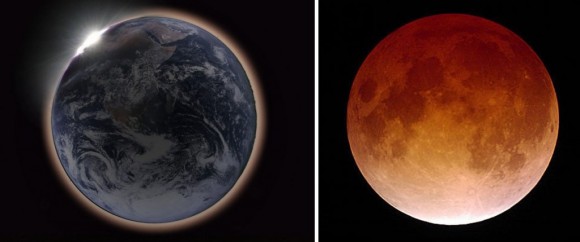
Photo credit: Fred Espenak
Super Blood Moon eclipse on night of September 27-28
During a lunar eclipse, you’ll see the Earth’s shadow creeping across the moon’s face. The shadow will appear dark, like a bite taken out of a cookie, until the shadow completely covers the moon. Then, during the breathtaking time of totality, the shadow on the moon’s face often suddenly changes. Instead of dark, it appears red. Why?
The reason stems from the air we breathe. During a total lunar eclipse, the Earth lies directly between the sun and the moon, causing the Earth to cast its shadow on the moon. If Earth didn’t have an atmosphere, then, when the moon was entirely within Earth’s shadow, the moon would would appear black, perhaps even invisible.
Thanks to Earth’s atmosphere, what actually happens is much more subtle and beautiful.
Earth’s atmosphere extends about 50 miles (80 kilometers) above Earth’s surface. During a total lunar eclipse, when the moon is submerged in Earth’s shadow, there is circular ring around Earth – the ring of our atmosphere – through which the sun’s rays pass.
Sunlight is composed of a range of frequencies. As sunlight passes through our atmosphere, the green to violet portion of the light spectrum is, essentially, filtered out. This same effect, by the way, is what makes our sky blue during the day. Meanwhile, the reddish portion of the spectrum is least affected.
What’s more, when this reddish light first entered the atmosphere, it was bent (refracted) toward the Earth’s surface. It’s bent again when it exits on the other side of Earth. This double bending sends the reddish light onto the moon during a total lunar eclipse.

The image at left is a photo montage. It combines the famous Blue Marble image taken by the Apollo 17 astronauts with an image of a solar eclipse. The composite simulates the reason a lunar eclipse looks red – because, during a lunar eclipse seen from Earth, a person on the moon would see a solar eclipse, with sunlight streaming around Earth, through our atmosphere. At right, a fully eclipsed moon takes on the reddish color of sunlight filtered and refracted through Earth’s atmosphere. Image at right via Jim Fakatselis. Composite image via AstroBob
Depending on the conditions of our atmosphere at the time of the eclipse (dust, humidity, temperature and so on can all make a difference), the surviving light will illuminate the moon with a color that ranges from copper-colored to deep red.
In December 1992, not long after the eruption of Mount Pinatubo in the Philippines, there was so much dust in Earth’s atmosphere that the totally eclipsed moon could barely be seen.
Can anyone know in advance how red the moon will appear during a total lunar eclipse? Not precisely. Before an eclipse takes place, you’ll often hear people speculating about it. That uncertainty is part of the fun of eclipses, so enjoy! And watch for the red moon during a lunar eclipse.

A lunar eclipse takes place when the sun, Earth and moon line up in space. The moon passes through Earth’s shadow. (Wikimedia Commons)
Bottom line: A moon may look red during a total lunar eclipse because of sunlight that is filtered and refracted by Earth’s atmosphere.

